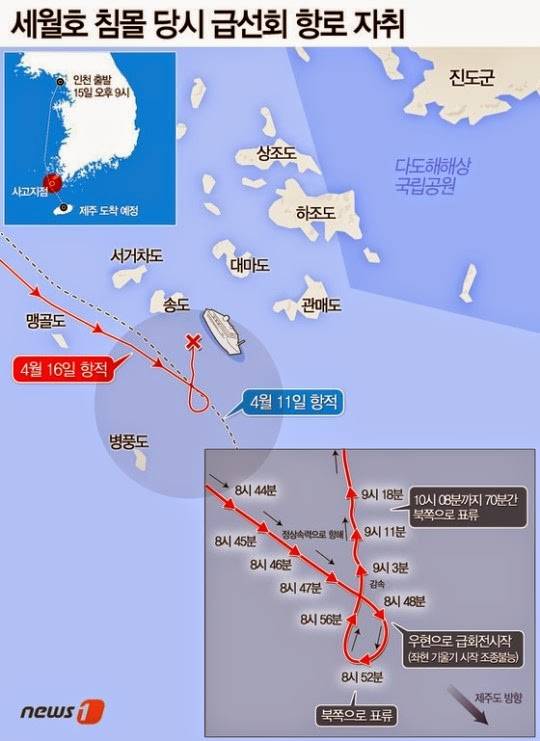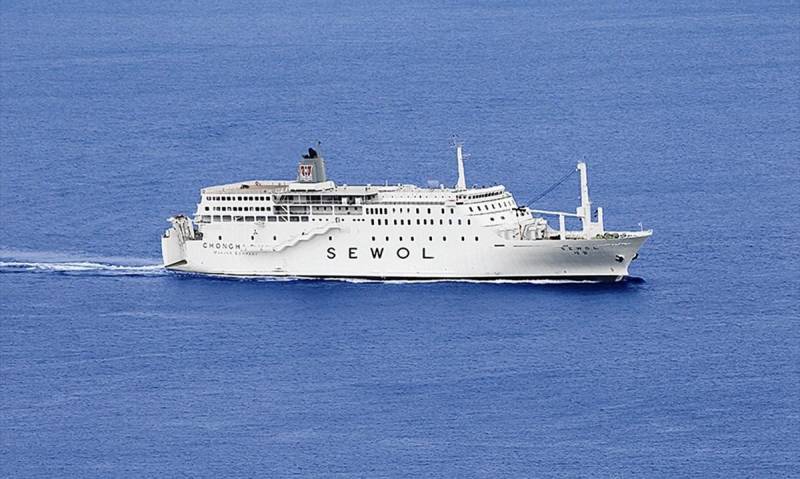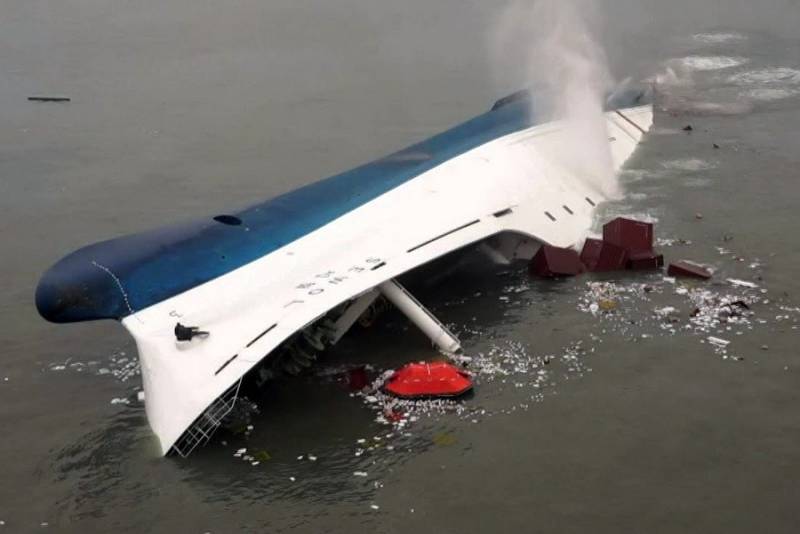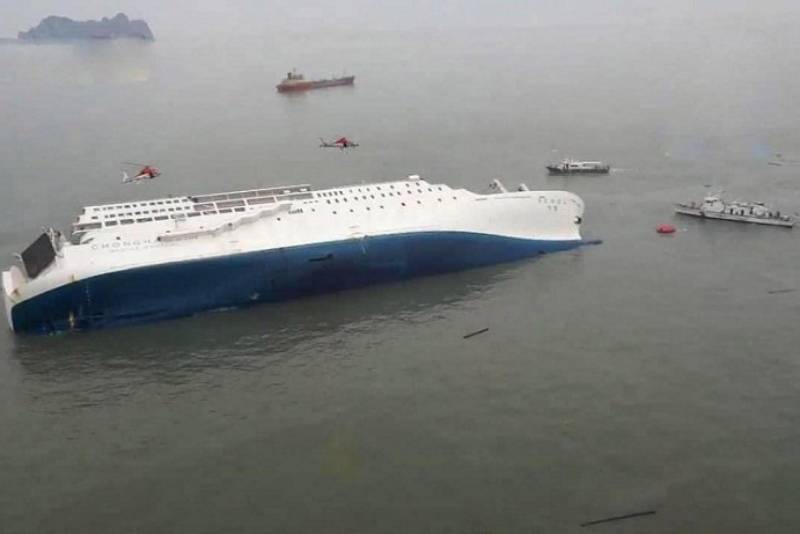Why did the South Korean ferry "Sevol" sink?
It just so happened that I took part in a long debate about the circumstances of the mysterious crash of the South Korean ferry Sevol, which capsized and sank during the flight from Incheon to Jeju Island on the morning of April 16, 2014. 304 people were killed, among them many schoolchildren. The catastrophe resulted in a large-scale criminal investigation, during which 339 people were arrested (out of 154 of them received court sentences), as well as in a whole social movement that played a serious role in impeachment of South Korean President Park Geun-hye, her subsequent arrest and sentencing 25 years in prison.
The topic is very interesting for some assessments related to the defense capability of South Korea, its ability to act in times of crisis, an unclear situation and strong psychological stress. The South Koreans have the ability to do this so-so, which can be seen not only in the epic of the Sevol ferry, but also in the no less interesting case with the mysterious sinking of the Cheonan corvette in 2010. The hysteria that quickly encompasses the whole society, South Koreans fall easily.
Almost from the first days of this shipwreck, which occurred under nontrivial circumstances, I had an opinion that contradicted what was written in the South Korean newspapers and that later became the official point of view on the causes of the disaster. Subsequently, I developed my position in the study of the causes of the ferry wreck, written and published in English, in which I put forward my version of why this happened and how.
What made me challenge South Korean public opinion (also broadcast by journalists, in particular Oleg Kiryanov, to Russian-language media)? Firstly, the surrealism of the picture itself. The ferry sank not in a storm, not in a typhoon, but in good weather, and for no apparent reason: during a turn there was a roll, the load shifted, the ferry lay on its port side and then capsized. The South Korean Coast Guard insisted on this. But I immediately had a doubt about it: nevertheless, the ships were built so that they would not capsize from the turn. Secondly, the case was not considered on the merits, because soon after the crash in the South Korean press, there was just a wave of emotions and tantrums against the captain of the ferry Lee Zhong Sok, who was accused of de-steaming the boat, escaped first, although he had to leave the last ferry, and even that he did not give an order for evacuation, so that passengers would not prevent him from escaping. Thirdly, I considered the captain’s life sentence to imprisonment and still consider it unfair without a detailed analysis of the reasons for the ferry’s wreck.
Generally, in this stories Three parts can be distinguished. The first part consists in the actual collapse of Sevol and the circumstances of this. The second part is a rescue operation. The third part consists in subsequent statements and interpretations, in violent political activity around this topic. I was most interested in the first part, and I tried not to touch on other parts, so as not to go into numerous side topics. Although the South Korean version of the wreck, in my opinion, was born as a result of the failure of the rescue operation, the reluctance of a number of people to be responsible for this, which later came in handy for the political struggle with Park Geun-hye, who was also accused of wrecking the ferry (along with the charge of other big and small misconduct).
I defined my position this way: we need to find out exactly what happened, because it is a matter of safety at sea. It's like in aviation, famous for its meticulous investigations: if you do not find out the causes of the crash, then another aircraft can get into a similar situation and get another crash, which can and should be avoided. And the South Koreans will somehow solve their political problems themselves.
In view of the understandable limitations on the volume of the article, I will set forth some facts as well-known (those who wish can deal with the English Wikipedia article on the ferry wreck; it provides a good reference compilation and necessary links).
It was a good ship
Where do we start? From the ship itself. The Sewol ferry was originally Japanese, built in 1994 by Hayashikane Shipbuilding & Engineering Co. Ltd in Nagasaki. It was one of the cruise ferries that have been built in Japan since 1981 and were primarily intended for sailing the Inland Sea between the islands. The ferry departed for 18 years in Japan, then was sold to South Korea and renamed. At the time of the crash, he was 20 years old.
"Sevol" had a displacement of 6835 tons, a deadweight of 3794 tons. Length 145,6 meters, width 22 meters, draft 6,26 meters. In Japan, the ferry had a passenger capacity of 804 people, in Korea additional decks were built on and increased capacity to 921 people (954 people in total, together with the crew). The ferry also accommodated 90 cars and 60 trucks.
The absurdity of the cause of the crash put forward by the South Koreans is already evident from this reference information. If the ferry would have a tendency to capsize on bends, then it would not go to sea for 20 years. Then, the ship is big. The force, in order to tumble him to the side, also had to be great.
It is also worth noting that the ferry was a good vessel, better than many ferries. The Japanese built it after the collapse of the British ferry Herald of Free Enterprise in March 1987. The nasal ramp opened, the steam tipped and sank in just 90 seconds. Sevol did not have a nose ramp; for cars, two aft ramps were installed. There was a cargo hold in the bow of the ferry, a crane was installed above it, on the ferry tank. The Japanese learned their lessons and made their ferry as safe as possible.
The ferry was not overloaded!
This is not to say that South Korean investigators did not think about the ridiculous nature of their version of the ferry’s wreck from turning. They tried to explain this also by the fact that the steam was overloaded, the new superstructure worsened the stability of the vessel, the cargo was not secured, and that’s why the steam went down.
True, they did it in a way that exposes them. They composed and launched into the press a tale that the ferry was supposed to carry only 987 tons of cargo, and had on board in its last voyage, according to various estimates, from 2142 to 3608 tons of cargo. For the public, everything seems to be clear: the overloaded steam could not help but tip over. Only this is deceptive clarity.
They wrote that the South Korean Maritime Register allegedly set a cargo limit of 987 tons. For some reason, this limit was not known to either the Korean Shipping Association or the Coast Guard. Moreover, a document was not submitted, it is a certifying one. This is the main evidence, the main explanation - a copy of this document indicating the loading limit should be everywhere. But he was not there, I could not find him. As well as other ship documents: ship declaration with the list of cargo, ship log. The documents from the ferry were definitely taken either during the underwater search operations, or after the ascent, but they did not reach the public. With documentary evidence in this case, it’s very bad, in fact, that only inflates suspicions.
In general, I believe that the limit was coined retroactively. Why? That's why.
Firstly, a merchant ship with a deadweight of about 3800 tons can carry about 3500 tons of cargo, since all other cargoes (fuel, supplies, water, etc.) are, in general, not too large. They try to make the cargo capacity larger, since the profitability of shipping depends on this. A cargo limit of 987 tons for a ship with a deadweight of 3794 tons or 26% of deadweight is pure absurd from the point of view of the economics of shipping.
Secondly, the weight of the cargo can be calculated. In its last voyage, Sevol took on board 124 cars (1,5 tons each - 186 tons), and 56 trucks (8 tons each - 448 tons). Total cars - 634 tons. The weight of the cargo that he could take can be roughly calculated from the dimensions of the automobile deck and hold. The length of the deck according to the ferry scheme is approximately 104 meters, a width of 20 meters, an area of 2080 square meters. meters. 124 cars and 56 trucks occupied about 1370 square meters. meters (5,4 square meters for cars and 12,5 square meters for trucks). Actually a little more, but this load fit on the deck. A cargo hold of 20 meters long, 20 meters wide and 7 meters high (2800 cubic meters capacity) could hold seventy 20-foot containers (each 39 cubic meters). Their weight with a full load of each container would be 1680 tons. On the deck of the tank, as can be seen in the photo, there were at least 12 containers (up to 288 tons in weight). Thus, Sevol could take on board 82 containers (up to 1968 tons when fully loaded) along with cars. That is, the maximum weight that the ferry could take on its last voyage could not exceed 2602 tons, or 68,5% of deadweight. Talking about overload is just ridiculous.
In reality, the load was less. It was reported that, in addition to cars, the ferry carried 1157 tons of cargo, including 400 tons of steel beams. If you add this load to the weight of the cars calculated earlier, you get 1791 tons of the total cargo, that is, less than reported, and less than the ferry could take on board. The containers were heavily underloaded. Those that stood on the deck of the tank fell overboard and swam for some time like floats, which implies that they did not have 24 tons for a fully loaded 20-foot container.
So, with all the errors, the cargo of Sevol can be roughly taken for 1800 tons. It is also known that the ferry received 761 tons of ballast water Tanks. The weight of passengers and crew (467 passengers and 35 crew members) is about 30 tons. I determined the fuel weight from the average fuel consumption of two diesel engines of the Pielstick 12PC2-6V-400 ferry with a total capacity of 11912 kW (0,2 kg per kW per hour). The ferry made a flight from Incheon to Jeju in 16 hours, that is, a round-trip flight required 32 running hours. Given the fuel consumption when parking in the port, I proceeded from the fact that the vessel had a fuel reserve of 48 hours, or 114 tons of diesel fuel.
Thus, according to my calculations, it turned out: cargo - 1800 tons, ballast - 760 tons, fuel - 114 tons, passengers and crew - 30 tons. A total of 2702 tons of net cargo or 71,2% of deadweight. The ferry cannot be considered overloaded in any weather.
In democratic countries, they sometimes plan and hang such noodles on their ears that it is amazing how people believe in this and even defend with foam in the mouth in discussions.
The passenger deck superstructure, which has been talked about so much, weighed 239 tons, which is not enough for Sevol. This extra weight was easily balanced by either water or a heavy load, such as trucks, construction equipment or the already mentioned steel beams.
As for cargo securing, on ferries, vessels with limited seaworthiness, which usually have seaworthiness up to 4-5 points (5 points - wind up to 9 m / s, wave height up to 2,2 meters), it is rarely practiced. A five-point wave barely moves a ship 146 meters long. In addition, Sevol had pitching dampers that were released at the time of the ferry’s crash. So when sailing a ferry in coastal waters, there was no practical need to secure cargo, as is done on ocean vessels.
Tidal current
The South Korean official version of the crash of the Sevol ferry, therefore, is linden. So, as they say, that is, from the turn, the ferry could not sink. In addition, it later turned out that between 08.46 and 08.48 p.m. on April 16, “Sevol” followed a course of 136 degrees and, on the orders of the third assistant captain Park Han Gul, began to lie down at a course of 145 degrees. The helmsman Cho Joon-gi turned the steering wheel 5 degrees to the starboard side. That is, there was no sharp turn, and over time, South Korean researchers were forced to admit it. And all this stream of emotions about the ferry overload and everything else that was listed, lost all meaning.
The investigators were clearly trying to find the cause of the crash inside the ferry so that the captain could be blamed and against the backdrop of this accusation, the guards of the Coast Guard for a poorly conducted rescue operation, which was actually unsuccessful, did not look so bright and convex.
I quite quickly came to the conclusion that the cause of the crash was outside the ferry. But which one? In the early days, there were versions about the collision of a ferry with an underwater rock (quickly rejected), then with an American submarine (rejected, but later). I rejected them immediately, since the underwater part of the overturned ferry on the starboard side was completely intact already in the photographs of it in a sinking state. Then the steam was lifted, and this became apparent with absolute clarity. No dents, no scuffs, not even peeled paint.
At the same time, eyewitnesses spoke of some kind of strong blow to the ship. One of the officers, who was in his cabin, was thrown out of bed by him. The strike was confirmed by the records of automobile registrars: cars flew along the cargo deck. Captain Lee Zhong Suk said at the court that the ferry course at the moment when he jumped to the bridge from his cabin immediately after the strike was 155 degrees. This statement was then not disputed by anyone. Such a strong blow that turned the ship ten degrees. Not weak, but left absolutely no marks on the case. And what could it be?
In search of an answer, I decided to find out what kind of place it was. The Sevol passed through the Mangol Strait, not far from the extreme southwestern tip of the Korean Peninsula. The first thing I learned about him is the strong currents caused by the tides. A large stream of water passes through a narrow strait (about 2 miles wide), and the flow rate reaches 11-12 knots. They even planned to build a tidal power station there. Wow! This is half the maximum ferry speed. If the ferry went against such a strong current, then it could have serious problems.
Now it remains to find out whether the "Sevol" went downstream or against it. In the American Sailing Directions (Enroute). Coast of Korea and China ”stated that the northwestern current began two hours after the peak of low tide (low water, LW) and ended two hours after the peak of high tide (high water, HW). Immediately after this, the reverse flow began in a southeast direction.
The time of the ebb and flow of tides is indicated in special guides: “Tide Tables. 2014. Central and Western Pacific Ocean and India Ocean. " I looked at this guide for April 16, 2014 and found out that in the nearby port of Busan the peak of low tide was at 02.42, and the peak of tide was at 09.04. Around the same time, the peak of low tide and the peak of high tide was in the Mangol Strait.
It is known that "Sevol" entered the strait at 08.27. He followed a southeastern course and for him the current, which began at about 05.00, was oncoming. It was supposed to end at 11.00, that is, the ferry entered the strait during the peak of the tide and the maximum flow velocity. He shouldn't have done that. The passage time of the strait according to the schedule was around 06.00, when the current was still weak. But the ferry was detained in the port of Incheon due to heavy fog, which prevented the vessel from exiting along a complex fairway. The delay led to unforeseen circumstances.
The ferry headed 165 degrees until 07.30 a.m. on April 16, after which it made a turn and lay down on the course 137 degrees (at 08.27 hours). Before the hit, the ferry passed about 1,5 miles and began to smoothly turn 140 degrees, then 145 degrees. Between the turns, the steam passed about one cablet in an arc. Then the steam entered the main stream of the tidal stream at an acute angle.

In the Mangol Strait, which is actually a gap between the two islands, the tidal current must be complex, it can be divided into several jets, but at the narrowest point the jet is the most powerful and fastest. The sea around the islands is deserted by the flow of numerous rivers, while the tide drove into the strait masses of salty, denser ocean water, this jet in narrowness was apparently just such, significantly denser. The ferry went at a speed of 18 knots, and the jet of the oncoming current ranged from 10 to 13 knots. For Sevol, entering it at such a speed was tantamount to running aground. Collision with the rapidly flowing mass of dense salt water - this is the blow that hit the bow of the vessel on the port side. This blow turned the ferry 10 degrees and tipped it immediately, according to the testimony of the helmsman, 15 degrees to the port side. This is too much for a ferry. The cargo on the car deck and in the hold fell to the port side, making it impossible to straighten the ship and predetermining further heeling, flooding and tipping. All this happened unexpectedly.
The situation was surreal. On a long-found route with a calm sea and good weather, it is not clear why the ferry began to roll and sink. This is a situation from the category of "that which cannot be." The roll, at first, according to various estimates, from 15 to 20 degrees, already 25 minutes after the hit reached 50 degrees. The crew members quickly realized that the Sevol would inevitably sink, and this was a shock for them, which broke and demoralized them. In my opinion, this was the main reason why they could not carry out the evacuation of passengers. In order to cope with the state of shock, it takes time, and they expired very quickly.
In fact, the disaster of the Sevol ferry is a product of an accidental combination of circumstances, which themselves rarely coincide. But from this we can conclude about the fundamental danger of currents in such straits. Then you can either completely close such straits for shipping, or you can oblige the dispatching service, which controls the movement of ships, to close them for those hours when the currents are the strongest.
Only this conclusion was not accepted in South Korea. It is understandable. It’s more convenient to talk about the “killer captain” (President Park Geun-hye gave him such a definition, but the current opposition in the government already prefers not to remember it), and about the president’s guilt in the ferry wreck, to kindle the emotions and hysteria that is used to mobilize the masses in the goals of a political campaign. Safety at sea remains behind the scenes. For this, they will one day have to pay another crash with numerous victims. By the way, Sevol is already the third ship that sank in South Korea with great casualties. The first was Namyon (December 15, 1970, 232 dead), and the second was Sohe (October 10, 1993, 292 dead).



Information